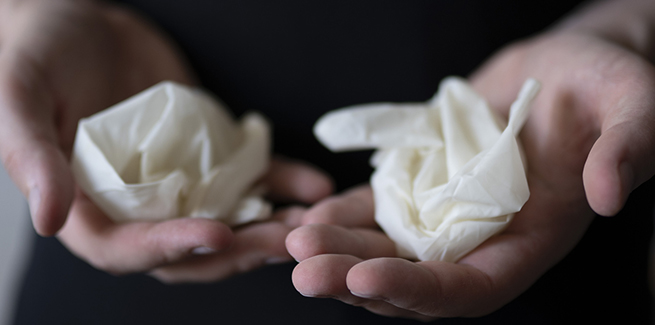Removing PPE the right way: Do you know how to doff?

As many as half of human healthcare workers don’t remove personal protective equipment (PPE) correctly, according to a 2015 study from the University of Wisconsin.
As part of the study, a trained observer watched 30 human health-care workers as they entered and left patient rooms in a hospital. Seventeen workers removed their gown before removing gloves (the gloves should come off first), and 16 wore their PPE out of the patient’s room (both gloves and gown should be removed before leaving the room).
Only about half of the workers in the study removed their PPE correctly, and of those who did, only 17% did so in the right order and disposed of it in the right place.
Removing PPE correctly helps reduce contamination, but “current removal practices are not well described,” the study states. And right now, when PPE isn’t easy to come by for many veterinary hospitals—both rationing and reuse are the order of the day in many hospitals—a quick refresher on the correct way to remove PPE seems timely.
The US Centers for Disease Control (CDC) website has comprehensive instructions on how to take off—they prefer the word “doff”—PPE gear, including downloadable posters and fact sheets.
(The CDC allows for more than one doffing method that may be acceptable and recommends training and practicing the doffing of PPE using your hospital’s standard doffing procedure.)
That said, here’s the step-by-step doffing method the CDC recommends on its website:
- Remove gloves. Ensure glove removal does not cause additional contamination of hands. Gloves can be removed using more than one technique (e.g., glove-in-glove or bird beak).
- Remove gown. Untie all ties (or unsnap all buttons). Some gown ties can be broken rather than untied. Do so in gentle manner, avoiding a forceful movement. Reach up to the shoulders and carefully pull gown down and away from the body. Rolling the gown down is an acceptable approach. Dispose in trash receptacle.*
- Healthcare personnel may now exit patient room.
- Perform hand hygiene.
- Remove face shield or goggles. Carefully remove face shield or goggles by grabbing the strap and pulling upwards and away from head. Do not touch the front of face shield or goggles.
- Remove and discard respirator (or facemask if used instead of respirator). Do not touch the front of the respirator or facemask.*
- Respirator: Remove the bottom strap by touching only the strap and bring it carefully over the head. Grasp the top strap and bring it carefully over the head, and then pull the respirator away from the face without touching the front of the respirator.
- Facemask: Carefully untie (or unhook from the ears) and pull away from face without touching the front.
If you’re not sure about how to handle PPE gear coming or going, the CDC site also has detailed instructions on best practices for putting on PPE gear—and they prefer the word “don.”
*Facilities implementing reuse or extended use of PPE will need to adjust their donning and doffing procedures to accommodate those practices.
Additionally, check out the sequence for donning and doffing PPE in the 2018 AAHA Infection Control, Prevention, and Biosecurity Guidelines (which include an update for COVID-19).
Photo credit: © iStock/Artem Laktikov



